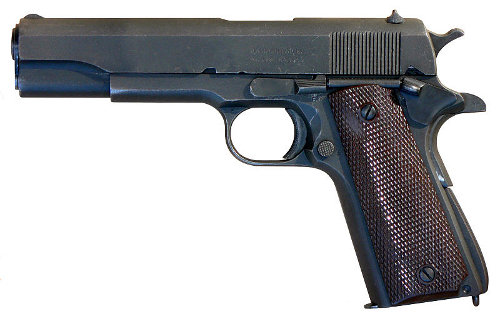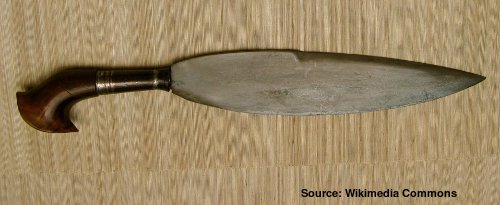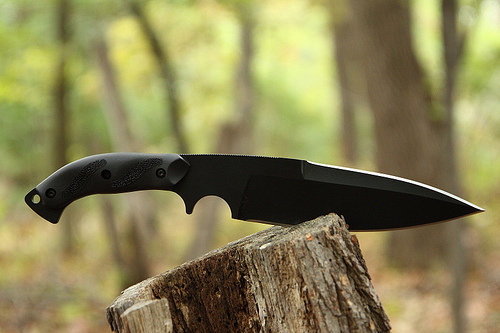
|
THE LIBERTARIAN ENTERPRISE Number 613, April 3, 2011 "To advance knowledge and to correct errors, unrestricted freedom of discussion is required." Attribute to The Libertarian Enterprise It has been my experience, at least so far, that people who live, work, and defend themselves every day with knives tend to prefer them large. I have discussed Bowie knives and kukris. Another case in point is the barong, wielded mostly by the Moros of the Philippines, the small but madly fierce warriors who forced the U.S. Army to throw its puny .38s on the junkheap of firearms history in favor of a return to the old, reliable .45 Colt, and ultimately to the 1911 .45 of song and legend. 
[That is not a knife] The song, by the way, is "Happy Birthday to You". The only other century-old item of technology that serves us as well today as it did our great grandfathers is Thomas Edison's light bulb which the current regime is attempting to assassinate, for no other reason than that it works perfectly. By contrast, the legislature of Utah, home of Saint John Moses Browning, has just made his invention the official state gun. But I digress, as usual.
But what's important is the weight. Wikipedia reports that the Spaniards who conquered the Philippines in the 17th century were dismayed to find out the hard way a well-wielded barong could cut through a musket barrel. It's said they're effective against M-14s, as well. Guess I'm gonna hafta add a barong to my collection.
The first is that conspicuous notch, where the trigger guard would be on a pistol, that gives you a choice of placing your index finger there and "choking up" on the handle for greater control—slicing vegetables or removing an appendix comes to mind—aided by a long, comfortably serrated section on the back of the blade for adding some thumb-power. Or you can hold onto the back end of the handle and cut kindling, disjoint chickens, or reply appropriately to initiated force. That the knife balances on this semicircular cutout can be no accident. The handle looks and feels kind of skinny, at first—until you actually use the knife. In fact, this may be the best thought-out knife that I own. Sadly, including those I have designed, myself. Let's get the naked specifications out of the way. The official blade length is 8.6 inches (four tenths below my usual specs), but with a perfect shape for thrusting, hacking, or making passing or draw cuts. The overall length 13.5 inches. You can see how it measures up to the legendary Marine Corps Ka-Bar: it's just a little bigger all around.
The knife is made, end to end, from 1085C high-carbon tool steel, and no, I don't know what that means, either, except that it isn't stainless, which has its good and bad points. (Someday I'll reveal the secret of getting and keeping stainless steel really sharp.) Perhaps one of my more metallurgically savvy readers can enlighten us—or maybe we could just look it up. My Tatang came very sharp on both edges. The whole knife is finished in matte black epoxy, also good and bad. Note that the Blackhawk Tatang can be had with a "plain" edge, or partially serrated. Over the years, I have come to appreciate all these sawtoothy blades more and more (although they're no good for whittling). The Spyderco Endura I carry every day is serrated from root to tip and has served me well for decades. My Tatang, however, was purchased on sale—roughly half price—from Amazon.com, of all places, and only the plain edge was available. I shall endeavor to persevere. The Tatang's handle consists of a pair of oddly-shaped little slabs of either thermoplastic or rubber (nobody seems able to decide), with textured sections for a firm grip—although the shape of the grip itself is very well designed for that purpose. I am aware that synthetic handle materials are controversial, especially among those who've "seen the elephant". For them, there are six little Allen screws that will allow them to subtitute the custom panels of their choice. Everybody else who has reviewed this knife appears to adore it. And to a man (no female reviewers, which is too bad), they hate, loathe, and despised the "reinforced ballistic nylon" scabbard that comes with it. As I've often said, sheaths are usually problematic for knife manufacturers, and Blackhawk is no different. Worst of all is the flimsy belt-loop riser in the back that I razored off the scabbard the first half hour I had it. Among other things, the snap-strap that's supposed to go around the handle wouldn't reach. There are seven very nice grommets, however, and I'll add a slab of eighth-inch black structural nylon from my scrap bin, held on by hockey mask screws. One will have a head that's a snap, and I'll add a slantng safety strap. If I have a factory sheath I haven't rebuilt I don't remmeber what it is. One good feature of the scabbard is that it's wholly ambidextrous, letting the handle curve either direction you may desire. Most of the critics want a Kydex sheath for the Tatang. For reasons I'll reserve for another column someday soon, I say anything but Kydex, please, which I dislike intensely. I'll make my own leather sheath if I need to. All in all, the Blackhawk Tatang is a great knife, traditional yet innovative in design. I'm afraid it's already replaced the knife I keep on the night table beside a large-caliber Glock that used to be a 1911. Time marches on and so does technology. It's also made me even more curious than I was before, and very interested in obtaining a couple of large double-hilted knives, specifically the Cold Steel Black Bear Classic, and the Schrade Heavy Bowie. It's the same as guns. So many knives, so little money. Author's note: manufacturers and purveyors of knives who wish to see their products reviewed by this column are invited to write to me at [email protected] for mailing details. In all cases, merchandise will remain the property of the author. Those items that I especially like may end up in the hands of the characters of my novels.
TLE AFFILIATE
|
 The barong has a large, leaf-shaped blade between eight and 22
inches long, a good point, and a down-curving handle that lays that
point right on the centerline of thrust. In addition to the long,
curved lower edge, half of the top edge is generally sharp. Where it
hasn't been ground into a daggerlike cross-section, it's exceedingly
thick.
The barong has a large, leaf-shaped blade between eight and 22
inches long, a good point, and a down-curving handle that lays that
point right on the centerline of thrust. In addition to the long,
curved lower edge, half of the top edge is generally sharp. Where it
hasn't been ground into a daggerlike cross-section, it's exceedingly
thick.
 In the meantime, I have something right here beside me that is
unquestionably better, a Blackhawk Tatang. Designed, it says here, by
edged-weapons expert Michael Janich, the Tatang is a not-so-mini
modern version of the ancient Moro knife, with a number of significant
improvements.
In the meantime, I have something right here beside me that is
unquestionably better, a Blackhawk Tatang. Designed, it says here, by
edged-weapons expert Michael Janich, the Tatang is a not-so-mini
modern version of the ancient Moro knife, with a number of significant
improvements.